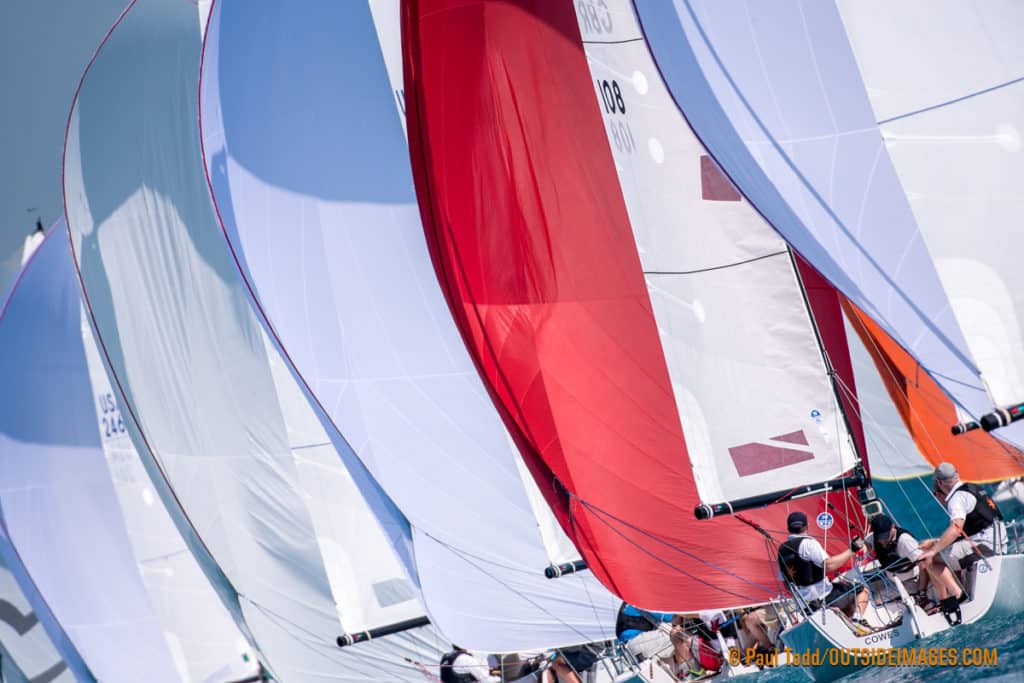
Thursday was another light and lumpy day. Onboard the J/70 Hoss we made some small adjustments to our setup and sailing style that seemed to help our speed:
Rig Tune: for most small keelboats, and also many dinghies, it is often fast to have the leeward cap shroud just coming loose. This usually requires easing the cap shrouds from their base tension. In the J/70, we eased our upper shrouds two full turns on the turnbuckles from the 10-knot setting. The D1 shroud also has to be eased to help sag the headstay and let the middle of the mast fall slightly to leeward in the middle.
For many boats, about a half-mast width of leeward sag is a good target. For us, that is 2.5 turns of ease from base tune. One of the reasons this is fast is because it reduces twist in the middle of the main (by dropping the front of the main to leeward). So to summarize a typical light air tune: leeward shroud just slack when going upwind, and the mast bent slightly to leeward in the middle though eased D1.
Other Settings: Essentially we are trying to make the sails more powerful (to a point) in order to increase drive and create a little weather helm (especially important in lumpy conditions). For the jib this means a soft headstay, but not so soft that it moves around excessively. This is achieved through the eased shrouds discussed above and little or no backstay (or soft runners).
For the main, the key is traveler up, sometimes all the way to the top of the track if it is really light, and using enough mainsheet to stall the top telltale but keep the second one flowing most of the time. If this creates more heel than you can hike out with crew weight, then drop the traveler a little bit. For boats with big powerful rigs, a little flatter main setup may be good (achieved through more pre-bend and mast butt aft) and a little backstay. For more underpowered boats, fuller is often better, as long as you can trim reasonably tight without stalling the second leech telltale.
Trim Technique: Generally, we want to maintain a constant angle of heel (as in all conditions) but in bigger waves a little bit more heel may make it easier to steer efficiently. Just make sure you are hiking before you start to ease the main or pull on too much backstay, because you want to harness all the available power. Jib trim is generally fairly tight with maximum in-haul, but not so tight that the upper leech telltale stalls more than occasionally.
In the bigger wave sets, a little jib ease is needed. Regarding steering technique, it is important to be smooth to avoid excess tiller movement. At the same time, you have to steer precisely and keep the jib telltales flowing back. In the lighter spots, make sure you are not pinching! Sometimes you actually get better height by keeping the boat moving fast, because the foils are more efficient.
My Next Crusade: I think it’s time to re-think how we call boats at the start, especially in big fleets. With no disrespect to the many great Race Committees out there, it can very difficult to identify all the boats that are over the line at the start. Mistakes are sometimes made, boats are missed or incorrectly identified, and there is often quite a time lag between the start and when the boats are called. And it is very stressful on the race committee, and requires a pretty high level of expertise.
I know it is the competitor’s responsibility to start correctly, and the race committee is not obligated to hail the over early boats. So they could simply put up the X flag and let the racers figure it out (this is how it is at the Olympics). But this is not really an ideal solution, because every boats wants the opportunity to sail the course correctly and get a score.
So I propose a technological solution that is used in the America’s Cup. Each boat has a GPS that is connected to a system that creates a virtual line and includes the timing of the start. Each boat has a light connected to the system. If the light goes on, you are over, and you go back. This would eliminate the human element, and I think would make for a fair race for all. It would also relieve a huge burden from the race committee.
I am not technically savvy enough to know exactly the mechanics of how this would work, but I am sure it is possible, and I think the cost is probably now low enough that it could become standard equipment for many competitive classes without undo financial hardship. Stan Honey, where are you?









